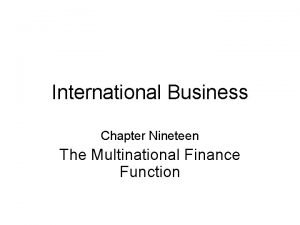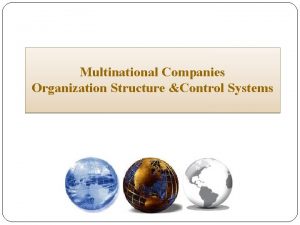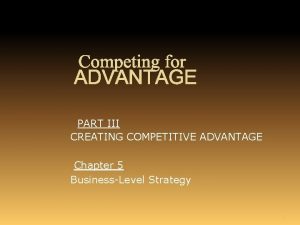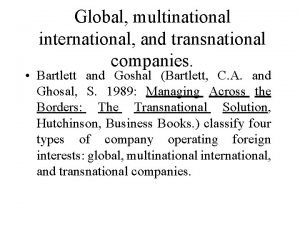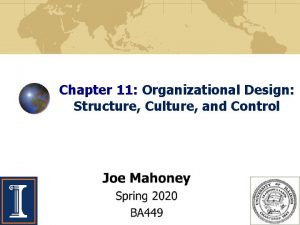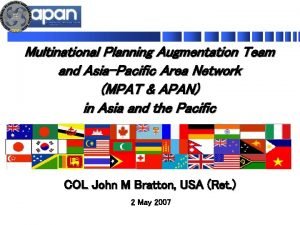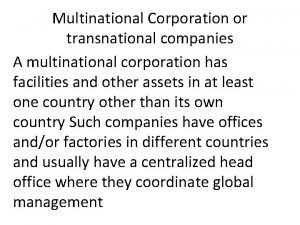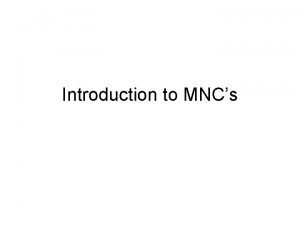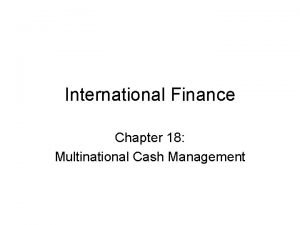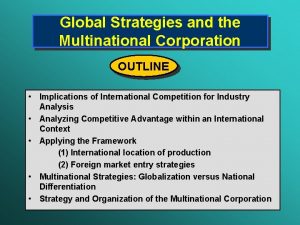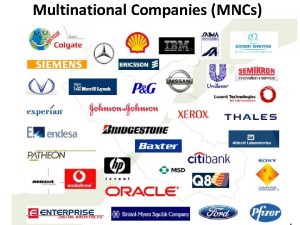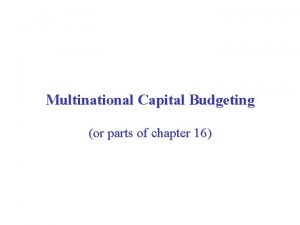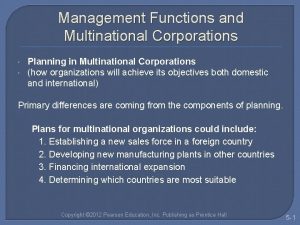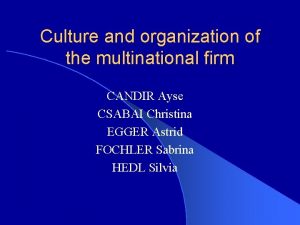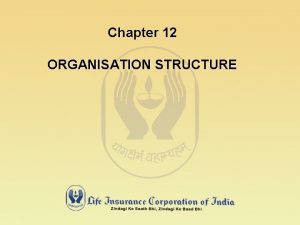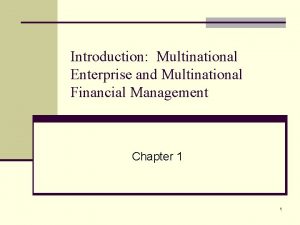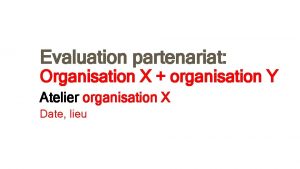Culture and Organisation in a Multinational Firm Structure

























































- Slides: 57

Culture and Organisation in a Multinational Firm

Structure of the presentation • Meaning of culture • Cultrural dimensions -national culture *Trompenaars and Hofstede -organizational culture • Case study

What’s culture? • A shared system of meanings • About groups-not about individual behavior • Learned-not inherited • Transgenerational • Patterned • Not “wright” or “wrong”

The Meaning of Culture • A Model of Culture

The Meaning of Culture • Culture as a Normal Distribution How Americans see the French • arrogant • flamboyant • hierarchical • emotional French Culture STEREOTYPES How French see Americans • naive • aggressive • unprincipled • workaholic U. S. Culture STEREOTYPES

Is their one best way of managing and organising? • No! Why? • Each culture has different meanings • One fact can have different meanings in different cultures • Example : the walkman • Hofstede and Trompenaars

Cultural differences : Trompenaars • • Universalism-particularism Individualism-communitarianisme Neutral-emotional Specific-diffuse Achievement-ascription Sequential-synchronic Inner-directed and outer-directed

1. Universalism-Particularism Universalism Particularism • • • Flexibility • It depends on the circumstance • Make exeptions • At ease with ambiguity Consistency Standards and rules Clarity Uniform procedures

1. Universalism-Particularism • A Car Accident What right has your friend? A. My friend has a definite right as a friend to expect me to testify to the lower figure. B. He has some right as a friend to expect me to testify to the lower figure. C. He has no right as a friend to expect me to testify to the lower figure.


2. Individualism. Communitarianism Individualism Communitarianism • I • Achieving alone • Ex. Vacations taken in pairs, even alone • We (part of a group) • Decisions taken in group • Ex. Vacations in group


3. Neutral-Affective Neutral Affective • Do not reveal what they are, thinking or feeling • Cool • Seem monotone • Physical contact = taboo • Reveal thoughts and feelings • Emotional • Heated, vital and animated • Seem dramatical


4. Specific-Diffuse Specific • Principles and behaviour independent of the person being addressed • Work and life are separated • Direct, to the point, purposeful in relating Diffuse • Everything depends of the context and the person • Work and private life are often very close • Indirect, seemingly aimless forms of relating

Specific culture Work Sport

Diffuse Culture


A Boss asking to paint the house • The colleague argues You don’t have to paint the house if you don’t feel like it. He is your boss in the company. Ouside the company, he has little authority. • The subordinate argues: Despite the fact that I don’t feel like it, I will paint the house anyway. He is my boss and you cannot ignore it outside your work either.


5. Achievement-Ascription What you do Who you are STATUS?

5. Achievement-Ascription Achievement • Competence determines status • Respect is based on achieving your job • Senior managers are of varying age Ascription • Extensive use of titles(who you are) • Respect is gained through your status (background) • Senior manager is mostly male, middle-aged and qualified by his background


6. Sequential-Synchronic Sequential • One activity at the time • Relationships are subordinate to the schedule • Preference to follow initial plans • Time is measurable Synchronic • More activities at the time • Schedules are subordinate to the relationship • Follow where relationships lead • Time is like a wide ribbon

7. Inner-directed VS outer-directed Inner-directed Outer-directed • Environment is in • I am in control • Dominating attitude • Flexible attitude, • Discomfort when the willing to compromise environment seems out • Comfort with of control waves, cycles if these are natural


Cultural differences : Geert Hofstede • Power distance • Uncertainty avoidance • Individualism • mascunility

1. Power distance the extent to which power is accepted High power distance Low power distance • • • Flat structure • Decentralized • Less supervisory personnel Obey blindly Steep structure Centralized A lot of supervisory personnel

2 Uncertainty avoidance High avoidance Low avoidance • High need for security • Strong belief in experts • Important structures • More written rules • Lower labor turnover • Example: Germany Japan • Accepting risk • Life must go on Less structural • Fewer written rules • Higher labor turnover • Example: Great-Britain Denmark

3. Individualism-Collectivism Individualism Collectivism • I • Belonging to a group • Greater individual initiative • Less individual initiative

4. Masculinity • = dominant values are success, money and things • Earnings, recognition and achievement is important • Independent decision makers Femininity • = dominant values are caring for others and the quality of life • Cooperation • Friendly atmosphere • Employment security • Group decision makers

Organizational culture • Definition of organizational culture • Characteristics • The interaction with national culture • Four categories for organizational culture

1/ Definition • Assumptions that are developed by a group through her existence • New members should adopt this way of thinking in order to fit with the organisation • The organizational culture of a MNC can differ a lot from one country to an other

2/Characteristics of Organizational Culture Observed behavioral regularities Norms Philosophy on treatment of employees/ customers Organizational Culture Dominant values Organizational climate Rules of employee behavior

3/ Interaction between national and organizational culture • National cultural values are significant • The values people bring to work can’t be changed easily

4/Four categories Equity Fulfillment-oriented Project-oriented culture INCUBATOR GUIDED MISSILE Person Emphasis Task Emphasis FAMILY Power-oriented culture EIFFEL TOWER Rule-oriented culture Hierarchy

4/Family Culture Equity Fulfillment-oriented Project-oriented culture INCUBATOR GUIDED MISSILE Person Emphasis Task Emphasis FAMILY Power-oriented culture EIFFEL TOWER Rule-oriented culture Hierarchy

4/ Family culture • • Power-oriented culture Diffuse relationships Status is ascribed (parent figures) Intuitive and error-correcting way of thinking People are seen like family members Father makes the changes Management by subjectives In conflict: do not lose your power

4/Eiffel tower culture Equity Fulfillment-oriented Project-oriented culture INCUBATOR GUIDED MISSILE Person Emphasis Task Emphasis FAMILY Power-oriented culture EIFFEL TOWER Rule-oriented culture Hierarchy

4/ eiffel tower culture • • • Role-oriented culture Specific relationships Status is ascribed to superior roles Rationally thinking People are seen like human ressources Change through rules and procedures Management by job description Criticism is accusation of irrationalism Everything is planned, structured

4/Guided missile culture Equity Fulfillment-oriented Project-oriented culture INCUBATOR GUIDED MISSILE Person Emphasis Task Emphasis FAMILY Power-oriented culture EIFFEL TOWER Rule-oriented culture Hierarchy

4/ Guided missile culture • • • Project-oriented culture Egalitarian and task-oriented Specific relationships Problem centered way of thinking People are seen as experts Management by objectives

4/Incubator culture Equity Fulfillment-oriented Project-oriented culture INCUBATOR GUIDED MISSILE Person Emphasis Task Emphasis FAMILY Power-oriented culture EIFFEL TOWER Rule-oriented culture Hierarchy

4/ Incubator culture • • Self-fulfilment oriented culture No structure Diffuse relationships Thinking is process-oriented and creative People are seen as co-creators Change is improvised Management by enthusiasm

Egalitarian • Den • Sweden • UK Person • Ita • Bel • Spain • Ger • Fra • Kor Hierarchical • Norway • USA • Irland Task

Managing Cultural Differences Process Reconciliation Resolve cultural differences Respect Appreciate cultural differences Recognition Increase awareness of one’s own cultural perception Time

CASE Cultural Transformation at NUMMI

NUMMI • Joint venture between Generals Motors and Toyota • US and Japanese culture needed mixed up • In order to get success, some differences needed to be reconciliated

Cultural Reconciliation Universalist Particularist • Obligation to report problems in order to improve system • Differences of opinion are accepted and valued • Flexibility of work rules • Tolerant atmosphere

Cultural Reconciliation Individualist Communitarist • Employment security • Participative decision making • Plant collective discipline • Managers closer to employees in order to give them support • Creation of open offices, communal cafetaria • Flat wage structure

Cultural Reconciliation Specific Diffuse • More than a workplace • Focus on quality and process rather than quantity • Building-trust first in order to achieve results

Cultural Reconciliation Achievement Ascription • Past achievement has no importance • More respect for the status of the superior

Cultural Reconciliation Sequential Synchronous • Transfer of the « just-in time » japanese type of managment • « Pull » instead of « Push » , • Synchronisation instead of sequence

Cultural Reconciliation Inner-directed Outer-directed • Flexibility • Looking for the problem instead of someone responsible

Cultural Reconciliation Low uncertainty avoidance High uncertainty avoidance • No lay-off • Job security • More flows of information

Cultural Reconciliation Low power distance High power distance • More respect for authority

NUMMI: Conclusion • Alone, Americans are much stronger than Japanese • In group the Japanese are much stronger than the Americans • Mix of two cultures can be beneficial for everybody • If you join two cultures and you can capture the positive points of both, you can get extraordinary results
 Finance function in multinational firm
Finance function in multinational firm Multinational capital structure
Multinational capital structure Multinational cost of capital and capital structure
Multinational cost of capital and capital structure Domestic structures
Domestic structures Multinational capital structure
Multinational capital structure Text structure and organisation
Text structure and organisation Non material culture examples
Non material culture examples Batch culture vs continuous culture
Batch culture vs continuous culture Difference between american and indian culture
Difference between american and indian culture Stab culture and stroke culture
Stab culture and stroke culture Folk culture and popular culture venn diagram
Folk culture and popular culture venn diagram Folk culture and popular culture venn diagram
Folk culture and popular culture venn diagram Stroke culture method
Stroke culture method Homework due today
Homework due today Lawn culture method
Lawn culture method Lawn or carpet culture method
Lawn or carpet culture method Surface culture deep culture and esol
Surface culture deep culture and esol Capital structure and firm value
Capital structure and firm value Project organisation structure
Project organisation structure School structure organization
School structure organization Ecommerce organizational structure
Ecommerce organizational structure Dgqa organisation structure
Dgqa organisation structure Sociologists define a symbol as
Sociologists define a symbol as Batch culture vs continuous culture
Batch culture vs continuous culture Collectivistic cultures
Collectivistic cultures A sub-culture group
A sub-culture group Adaptive culture from inert culture
Adaptive culture from inert culture Quality culture
Quality culture Organizational structure specifies the firm's:
Organizational structure specifies the firm's: Four strategic choices for mnes
Four strategic choices for mnes Multinational vs transnational
Multinational vs transnational What is multinational capital budgeting
What is multinational capital budgeting International accounting and multinational enterprises
International accounting and multinational enterprises Organizational design: structure, culture, and control
Organizational design: structure, culture, and control Organizational culture diagnosis worksheet
Organizational culture diagnosis worksheet Advantage of sole proprietorship
Advantage of sole proprietorship Multinational planning augmentation team
Multinational planning augmentation team Multinational market groups form
Multinational market groups form Multinational vs transnational
Multinational vs transnational Is kfc a multinational company
Is kfc a multinational company Multinational insurance programs
Multinational insurance programs Introduction to mnc
Introduction to mnc Morgans model of ihrm
Morgans model of ihrm Netting in finance
Netting in finance Multinational strategy vs global strategy
Multinational strategy vs global strategy Definition of mncs
Definition of mncs Strategic management in multinational companies
Strategic management in multinational companies Multinational management is
Multinational management is Multinational capital budgeting
Multinational capital budgeting Pds group bangladesh
Pds group bangladesh Dilbert estonia
Dilbert estonia Disadvantages of mncs
Disadvantages of mncs Multinational capital budgeting
Multinational capital budgeting Management and its functions
Management and its functions Multinational capital budgeting example
Multinational capital budgeting example Small multinational companies
Small multinational companies Multinational state
Multinational state Multinational financial management requires that
Multinational financial management requires that
